Effect of Organic Matter Fertilizers on the Composition of Volatiles, Morphometrical and Anatomical Parameters of Essential Oil-Bearing Thymus × citriodorus Cultivated in an Open Field Conditions
Abstract
:1. Introduction
2. Materials and Methods
2.1. Plant Cultivation and Fertilization
2.2. Collection and Analysis of Soil Material
2.3. Analysis of Plants’ Morphometrical Parameters
2.4. Analysis of Anatomical Parameters
2.5. Essential Oil Analysis
2.6. Statistical Analysis
3. Results
3.1. Influence of Fertilization on Soil pH and Chemical Composition
3.2. Influence of Fertilization on Biomass and Some Morphometrical Parameters of Plants
3.3. Influence of Fertilization on Anatomical Parameters of Thymus × citriodorus
3.4. Inluence of Fertilization on Quantitative and Qualitative Composition of Essential Oil
4. Discussion
5. Conclusions
Author Contributions
Funding
Institutional Review Board Statement
Informed Consent Statement
Data Availability Statement
Conflicts of Interest
Appendix A
| Chemical Compound | Fertilization Treatment | |||
|---|---|---|---|---|
| Control | Liquid Cattle Dung | Humus | ||
| First experimental year | ||||
| Geraniol | Mean ± SD | 24.48 ± 1.13 | 23.78 ± 0.44 | 26.27 ± 2.73 |
| Min | 22.78 | 23.12 | 22.42 | |
| Max | 25.07 | 24.04 | 28.74 | |
| CV | 5 | 2 | 10 | |
| Geranial | Mean ± SD | 12.27 ± 0.39 | 11.97 ± 1.04 | 13.04 ± 1.31 |
| Min | 11.75 | 10.93 | 11.39 | |
| Max | 12.68 | 13.41 | 14.23 | |
| CV | 3 | 9 | 10 | |
| Nerol | Mean ± SD | 14.62 ± 0.73 | 14.73 ± 2.13 | 14.20 ± 1.97 |
| Min | 13.96 | 12.12 | 11.43 | |
| Max | 15.66 | 17.15 | 16.06 | |
| CV | 5 | 14 | 14 | |
| Neral | Mean ± SD | 10.95 ± 0.44 | 11.27 ± 1.99 | 10.63 ± 2.00 |
| Min | 10.33 | 9.26 | 7.84 | |
| Max | 11.33 | 13.27 | 12.52 | |
| CV | 4 | 18 | 19 | |
| Germacrene D-4-ol | Mean ± SD | 9.12 ± 0.91 | 6.66 ± 1.66 | 8.74 ± 0.70 |
| Min | 8.24 | 5.20 | 8.13 | |
| Max | 10.22 | 9.00 | 9.60 | |
| CV | 10 | 25 | 8 | |
| Second experimental year | ||||
| Geraniol | Mean ± SD | 23.91 ± 1.35 | 23.60 ± 2.58 | 20.55 ± 2.78 |
| Min | 22.42 | 20.06 | 17.62 | |
| Max | 25.72 | 26.11 | 23.15 | |
| CV | 6 | 11 | 14 | |
| Geranial | Mean ± SD | 14.40 ± 0.56 | 13.47 ± 0.45 | 12.59 ± 1.62 |
| Min | 13.90 | 13.08 | 10.78 | |
| Max | 15.18 | 14.11 | 13.92 | |
| CV | 4 | 4 | 13 | |
| Nerol | Mean ± SD | 12.75 ± 5.67 | 15.73 ± 1.10 | 12.29 ± 1.70 |
| Min | 5.14 | 14.38 | 10.65 | |
| Max | 17.32 | 17.06 | 14.04 | |
| CV | 45 | 7 | 14 | |
| Neral | Mean ± SD | 10.95 ± 0.44 | 11.27 ± 1.99 | 10.63 ± 2.00 |
| Min | 10.33 | 9.26 | 7.84 | |
| Max | 11.33 | 13.27 | 12.52 | |
| CV | 4 | 18 | 19 | |
| Germacrene D-4-ol | Mean ± SD | 9.12 ± 0.91 | 6.66 ± 1.66 | 8.74 ± 0.70 |
| Min | 8.24 | 5.20 | 8.13 | |
| Max | 10.22 | 9.00 | 9.60 | |
| CV | 10 | 25 | 8 | |
| Parameter of Thymus × citriodorus | p/U | p/t | ||
|---|---|---|---|---|
| Fertilization Treatment | ||||
| Liquid Cattle Dung | Humus | Liquid Cattle Dung | Humus | |
| First experimental year | ||||
| Biomass | 0.02/0.0 | 0.77/7.0 | – | – |
| Percentage of essential oil | 0.16/44.0 | 0.46/36.0 | – | – |
| Percentage of geraniol | 0.25/4.0 | 0.25/4.0 | – | – |
| Percentage of geranial | 0.39/5.0 | 0.39/5.0 | – | – |
| Percentage of neral | 1.00/8.0 | 0.77/7.0 | – | – |
| Percentage of nerol | 1.00/8.0 | 1.00/8.00 | – | – |
| Percentage of germacrene D-4-ol | 0.08/2.0 | 0.39/5.0 | – | – |
| Height of plant | – | – | 0.00/−7.38 * | 0.41/−0.83 |
| Area of plant | – | – | 0.00/−5.45 * | 0.97/0.04 |
| Number of inflorescences of plant | – | – | 0.04/−2.09 * | 0.93/−0.09 |
| Length of inflorescences | – | – | 0.00/−10.67 * | 0.73/0.34 |
| Density of stomata (upper epidermis) | – | – | 0.08/1.78 | 0.84/−0.19 |
| Density of glandular trichomes (upper epidermis) | – | – | 0.33/−0.98 | 0.00/−3.10 * |
| Size of glandular trichomes (upper epidermis) | – | – | 0.90/0.12 | 0.47/−0.72 |
| Density of stomata (lower epidermis) | – | – | 0.00/−4.00 * | 0.1/−1.70 |
| Density of glandular trichomes (lower epidermis) | – | – | 0.20/1.30 | 0.55/0.60 |
| Size of glandular trichomes (lower epidermis) | – | – | 0.10/1.65 | 0.13/−1.52 |
| Second experimental year | ||||
| Biomass | 0.39/5.0 | 0.25/4.0 | – | – |
| Percentage of essential oil | 0.18/158 | 0.04/31.5 | – | – |
| Percentage of geraniol | 1.00/8.0 | 0.08/1.0 | – | – |
| Percentage of geranial | 0.06/1.5 | 0.08/1.0 | – | – |
| Percentage of neral | 0.39/5.0 | 0.72/5.0 | – | – |
| Percentage of nerol | 0.77/7.0 | 0.72/5.0 | – | – |
| Percentage of germacrene D-4-ol | 0.39/5.0 | 0.29/3.0 | – | – |
| Height of plant | – | – | 0.48/−0.71 | 0.03/2.16 * |
References
- Ložienė, K.; Vaičiulytė, V.; Maždžierienė, R. Influence of metereological conditions on essential oil composition in geraniol bearing Thymus pulegioides and Thymus hybrid. Acta Physiol. Plant. 2021, 43, 27. [Google Scholar] [CrossRef]
- Toncer, O.; Karaman, S.; Diraz, E.; Sogut, T.; Kizil, S. Essential oil composition of Thymus × citriodorus (Pers.) Screb. at different harvest stages. Not. Bot. Horti. Agrobo. 2017, 42, 185–189. [Google Scholar] [CrossRef] [Green Version]
- Paslawska, M.; Sala, K.; Nawirska-Olzanska, A.; Stępien, B.; Pląskowska, E. Effect of different drying techniques on dehydratation kinetics, physical properties and chemical composition of lemon thyme. Nat. Prod. Commun. 2020, 15, 1–12. [Google Scholar] [CrossRef] [Green Version]
- Kizil, O.; Toncer, Ő. Essential oil and microelement composition of Thymus × citriodorus L. and Lippia citriodora H.B.K. Cercet. Agron Mold. 2016, 2, 97–105. [Google Scholar] [CrossRef] [Green Version]
- Chen, W.; Viljoen, M. Geraniol—A rewiev of commercially important fragrance material. S. Afr. J. Bot. 2010, 76, 643–651. [Google Scholar] [CrossRef] [Green Version]
- Purbajanti, E.D.; Slamet, W.; Fushkak, E.; Rosyida, R. Effects of organic and inorganic fertilizers on growth, activity of nitrate reductase and chlorophyll contents of peanuts (Arachis hypogaea L.). Earth Environ. Sci. 2019, 250, 1–7. [Google Scholar] [CrossRef]
- Nurzynska-Wierdak, R. Does mineral fertilization modify essential oil content and chemical composition in medical plants. Acta Sci. Pol. Hortorumcultus 2013, 12, 3–16. [Google Scholar]
- Vaičiulytė, V.; Ložienė, K.; Taraškevičius, R.; Butkienė, R. Variation of essential oil composition of Thymus pulegioides relation in soil chemistry. Ind. Crops Prod. 2016, 95, 422–433. [Google Scholar] [CrossRef]
- Radanovic, D.; Mladenovic, S.A.; Markovic, T.L. Influence of soil characteristics and nutrient supply on medicinal and aromatic plants. In Proceedings of the III Conference of Medicinal and Aromatic Plants of Southeast European Countries, Nitra, Slovakia, 5–8 September 2004. [Google Scholar]
- Shaji, H.; Chandran, V.; Mathew, L. Organic fertilizers as a route to controlled release of nutrients. In Controlled Release Fertilizers for Sustainable Agriculture; Lewu, F.B., Volova, T., Sabu, T., Rakhimol, K.R., Eds.; Academic Press: Cambridge, MA, USA; Elsevier: Amsterdam, The Netherlands, 2020; pp. 2231–2245. [Google Scholar] [CrossRef]
- Matsi, T.; Lithourgidis, A.S.; Barbayannis, N. Effect of liquid cattle manure on soil chemical properties and corn growth in northen Greece. Exp. Agric. 2014, 51, 435–450. [Google Scholar] [CrossRef]
- Evulo, B.S.; Hasan, K.O.; Ojeniyi, S.O. Comparative effect of cowdung manure on soil and leaf nutrient and yield of pepper. Int. J. Agric. Res. 2007, 2, 1043–1048. [Google Scholar] [CrossRef]
- Prasad, A.; Kothari, N. Cow products: Boon to human health and food security. Trop. Anim. Health Prod. 2022, 54, 2–20. [Google Scholar] [CrossRef]
- Aşik, B.B.; Turan, M.A.; Celik, H.; Katkat, A.V. Effects of humic substances on plant growth and mineral nutrients uptake of wheat (Triticum durum cv. Salihli) under conditions of salinity. Asian J. Crop Sci. 2009, 1, 87–95. [Google Scholar] [CrossRef] [Green Version]
- Khaled, H.; Fawy, H.A. Effect of different levels of humic acids on the nutrient content, plant growth and soil properties under conditions of salinity. Soil WaterRes. 2009, 6, 21–29. [Google Scholar] [CrossRef] [Green Version]
- Celik, H.; Katkat, A.V.; Aşik, B.B.; Turan, M.A. Effect of humus on growth and nutrient uptake of maize under saline and calcareous soil conditions. Zemdirb. Agric. 2010, 97, 15–22. [Google Scholar]
- Pant, P.; Pandey, S.; Dall’Acqua, S. The influence of environmental conditions on secondary metabolites in medicinal plants: Aliterature review. Chem. Biodivers. 2021, 18, e2100345. [Google Scholar] [CrossRef] [PubMed]
- Roy, S.K.; Roy, D.K. Use of medicinal plants and its vulnerability due to climatic change in Northern part of Bangladesh. Am. J. Plant. Sci. 2016, 7, 1782–1793. [Google Scholar] [CrossRef] [Green Version]
- Matlok, N.; Stępien, A.E.; Gorzelany, J.; Woinarowska-Novak, R.; Balawejder, M. Effects pf organic and mineral fertilizationon yield and selected quality parameters for dried herbs of two varieties of oregano (Origanum vulgare L.). Appl. Sci. 2020, 10, 5503. [Google Scholar] [CrossRef]
- Gerami, F.; Moghaddam, P.R.; Ghorban, R.; Hassani, A. Effects of irrigation levels and organic manure on morphological traits, essential oil content and yield of oregano (Origanum vulgare L.). An. Acad. Brass. Sci. 2016, 88, 2375–2385. [Google Scholar] [CrossRef] [Green Version]
- Hendawy, S.F.; Azza, A.; El-Din, E.; Aziz, E.E.; Omer, A.E. productivity and quality of Thymus vulgaris L. under organic fertilization conditions. Ozean J. Appl. Sci. 2010, 3, 203–216. [Google Scholar]
- Khalid, A.; Hussein, M.S. Effect of cattle and liquid manures on essential oil and antioxidant activities of celery (Apium graveolens L.) fruits. J. Essent-Oil Bear. Plants 2012, 15, 97–107. [Google Scholar] [CrossRef]
- Zahara, M.; Suwarniati, A.; Aini, Q.; Muslim, M. The effect of organic fertilizers on the leaf morphology and stomata density of Pogestemon cablin Benth. J. Nat. 2021, 21, 52–56. [Google Scholar] [CrossRef]
- Bilkova, I.; Kjaer, A.; van der Kooy, F.; Lommen, W.J.W. Effects of N fertilization on trichomes density, leaf size and artemisin production in Artemisia annua leaves. Acta Hortic. 2016, 1125, 369–376. [Google Scholar] [CrossRef]
- Onauskas, A.; Dambrauskas, K. Agrochemiko Žinynas; Mokslas: Vilnius, Lithuania, 1984; pp. 73–75. [Google Scholar]
- Dagys, A.; Bluzmanas, P.; Putrimas, A. Augalų Fiziologijos Laboratorinia Idarbai; Mintis: Vilnius, Lithuania, 1965; p. 309. [Google Scholar]
- Adams, R.P. Identificationof Essential Oil Components by Gas Chromatography/Mass Spectometry, 4th ed.; Allured Publishing Corp.: Carol Stream, IL, USA, 2007; pp. 104–550. [Google Scholar]
- Solaiman, Z.M.; Yang, H.; Archdeacon, D.; Tippeti, O.; Tibi, M.; Whiteley, A.S. Humus–rich compost increases lettuce growth, nutrient uptake, mycorrhizal colonisation and soil fertility. Pedosphere 2019, 29, 170–179. [Google Scholar] [CrossRef]
- Mirchooli, F.; Kiani-Harchegani, M.; Darvishan, A.K.; Falahatkar, S.; Sadehi, S.H. Spatial distribution dependency of soil organic carbon content to important. Ecol. Indic. 2020, 116, 106473. [Google Scholar] [CrossRef]
- Pineiro, G.; Paruelo, J.M.; Oesterheld, M.; Jobbagy, J.G. Pathways of grazing effects on soil organic carbon and nitrogen. Regeland Ecol. Manag. 2010, 63, 109–119. [Google Scholar] [CrossRef]
- Stehouver, R. Soil chemistry and the quality of humus. Biocycle 2004, 45, 41. [Google Scholar]
- Dar, J.S.; Cheema, M.A.; Rehmani, M.I.A.; Khuhro, S.; Rajput, S.; Virk, A.L.; Hussain, S.; Bashir, M.A.; Alghanem, S.M.; Al-Zuaibr, F.M.; et al. Pottasium fertilization improves growth, yield and seed quality of sunflower (Hellianthus annus L.) under drought stress at different growth stages. PLoS ONE 2021, 16, e0256075. [Google Scholar] [CrossRef] [PubMed]
- Zahra, M.K.M.; Monib, S.I.; Abbdel-Al, S.; Heggo, A. Significance of soil inoculation with silicate bacteria. Zentrabl. Microbiol. 1984, 139, 349–357. [Google Scholar] [CrossRef]
- Roslon, W.; Osinska, E.; Bączek, K.; Węglarz, Z. The influence of organic–mineral fertilizers on yield and raw material quality of chosen plants of the Lamiaceae family from organic cultivation. Acta. Sci. Pol. Hortorum Cultus 2011, 10, 147–158. [Google Scholar]
- Samani, J.L.; Pirbalouti, A.G.; Malekpoor, F. Effect of organic and chemical fertilizers on growth parameters and essential oil of Iranian Basil (Ocimum basilicum L.). J. Crop Nutr. Sci. 2017, 3, 14–24. [Google Scholar]
- Rahman, K.M.; Sattar, M.A.; Rahman, G.M.M. Effect of fertilizer and manures on growth and yield of Tulsi and Pudina. J. Environ. Sci. Nat. Resour. 2014, 7, 13–16. [Google Scholar]
- Costa, A.G.; Bertolucci, S.K.V.; Chagas, J.H.; Ferraz, E.O.; Pinto, J.E.B.P. Biomass production, yield and chemical composition of peppermint essential oil using different organic fertilizer sources. Cienc. Agrotec. 2013, 37, 202–210. [Google Scholar] [CrossRef] [Green Version]
- Grigal, D.F.; Vance, E.D. Influence of soil organic matter on forest productivity. N. Z. J. For. Sci. 2000, 30, 169–205. [Google Scholar]
- Manukyan, A.; Schniztler, W.H. Influence of air temperature on productivity and quality of some medicinal plants under controlled environmet conditions. Eur. J. Hortic. Sci 2006, 71, 26–35. [Google Scholar]
- Nadjati, F.; Shabahang, J.; Dambhani, M.A.M. Effects on salinyti and temperature on germination and seedling growth of nine medicinal plant species. Seed Technol. 2010, 32, 93–107. [Google Scholar]
- Hui, D.; Yu, C.L.; Deng, Q.; Dzantor, E.K.; Zhou, S.; Dennis, S.; Sauve, R.; Jonhson, T.L.; Fay, P.A.; Shen, W.; et al. Effects of precipitation changes on swichgrass photosynthesis, growth and biomass: A mesocosm experiment. PLoS ONE 2018, 13, e0192555. [Google Scholar] [CrossRef]
- Saldana y Hernandez, M.I.; Gomez-Alvarez, R.; Rivera-Cruz, M.C.; Alvarez-Solis, J.D.; Pat-Fernandez, J.M.; Ortiz-Garcia, C.F. The influence of organic fertilizers on the properties of soil and production of Alpinia purpurata. Cien. Ing. Agr. 2014, 41, 215–224. [Google Scholar] [CrossRef] [Green Version]
- Hartz, T.K. Evaluation of Humic Substances Used in Commercial Fertilizer Formulation. Final Report, Frep Project 07-0174; 2007; pp. 1–23. Available online: https://www.cdfa.ca.gov/is/ffldrs/frep/pdfs/completedprojects/07-0174Hartz.PDF (accessed on 10 August 2022).
- Shen, J.; Gou, M.; Wang, Y.; Yuan, X.; Dong, S.; Song, X. An investigation into the beneficial effects and molecular mechanisms ob humic acid on foxtal millet after drought conditions. PLoS ONE 2020, 15, e0234029. [Google Scholar] [CrossRef]
- Huchhellman, A.; Boutry, M.; Hachez, C. Plant glandular trichomes: Natural cell factories of high biotechnological interest. Plant Psysiol. 2017, 175, 6–22. [Google Scholar] [CrossRef]
- Talebi, S.H.; Nohooji, M.G.; Yarmohammadi, M.; Khani, M.; Matsyura, A. Effect of altitude of essential oil composition in three Nepata species (N. sessilifolia, N. heliotropifolia, N. fissa). Mediterr. Bot. 2019, 40, 81–93. [Google Scholar] [CrossRef] [Green Version]
- Rodolfi, M.; Barbanti, M.; Giordano, C.; Rinaldi, M.; Fabbri, A.; Pretti, L.; Casolari, R.; Beghe, D.; Petruccelli, R.; Ganino, T. The effect of different organic fertilization on physiological and chemical characters in hop (Humulus lupulus L., cv Cascade) leaves and cones. Appl. Sci. 2021, 11, 6778. [Google Scholar] [CrossRef]
- Kardiman, R.; Ræbild, A. Relationship between stomata density, size and speed of opening Sumatran rainforest species. Tree Physiol. 2017, 38, 696–705. [Google Scholar] [CrossRef] [PubMed]
- Sakoda, K.; Yamori, W.; Shimada, T.; Sugano, S.S.; Hara-Nishimura, I.; Tanaka, Y. Higher stomata density improves Photosynthesis induction and biomass production in Arabidopsis under fluctuating light. Front. Plant. Sci. 2020, 11, 589603. [Google Scholar] [CrossRef] [PubMed]
- Yavari, A.; Nazeri, V.; Sefidkon, F.; Hassani, M.E. Influence of some environmental factors on the essential oil variability of Thymus migricus. Nat. Prod. Commun. 2010, 5, 943–948. [Google Scholar] [CrossRef] [PubMed] [Green Version]
- Sardashti, A.R.; Ganjali, A.; Kordi, A. Effect of humic substances on the quality of essential oils from medicinal plants. Bothalia 2014, 44, 280–300. [Google Scholar]
- Caceres, J.A.; Cuervo, J.L.A.; Rodriguez, L.C. Effect of organic fertilization on yield and quality of rosemary (Rosmarinus officinalis L.) essential oil. Agron. Colomb. 2017, 35, 232–237. [Google Scholar] [CrossRef]
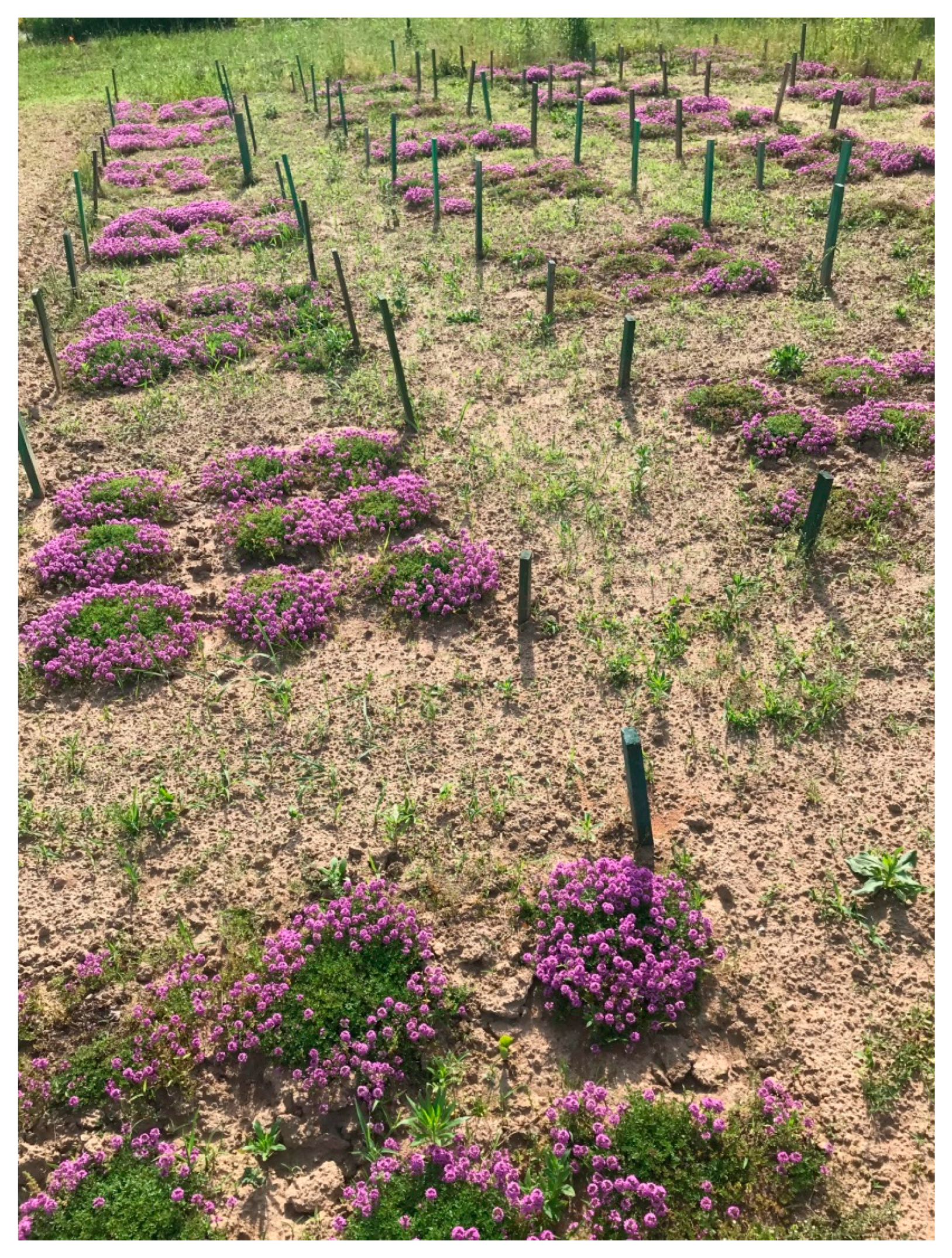
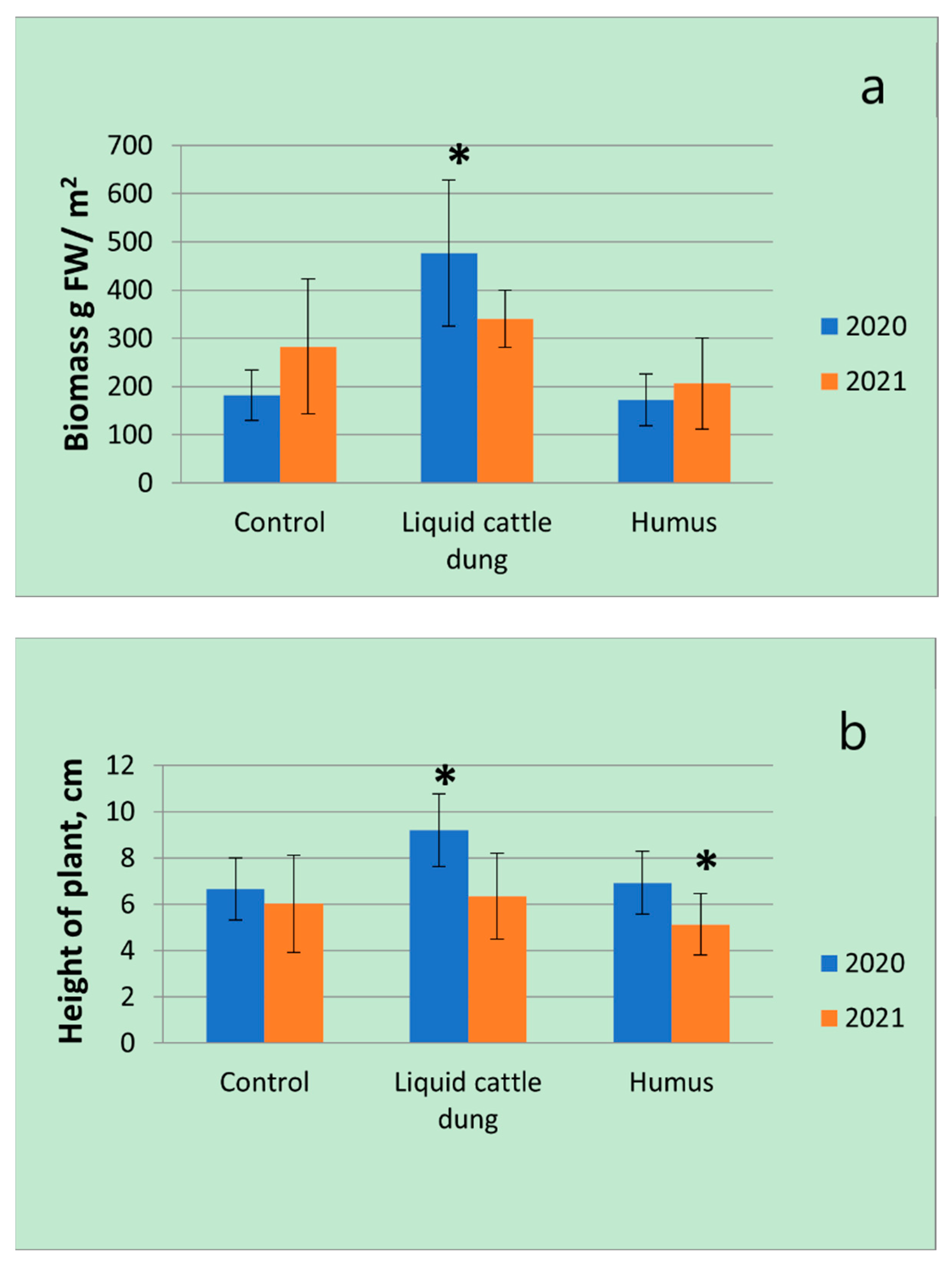
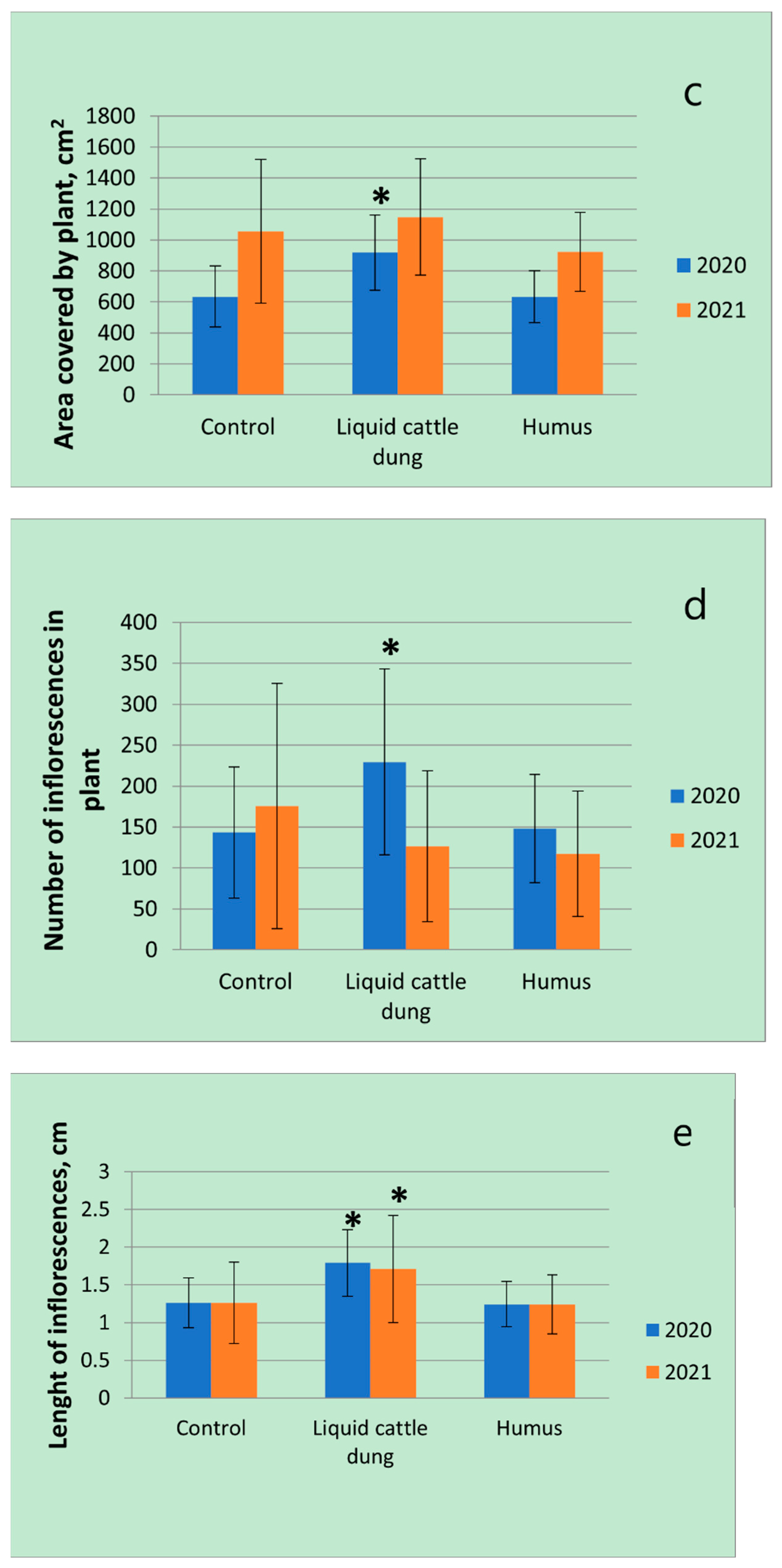
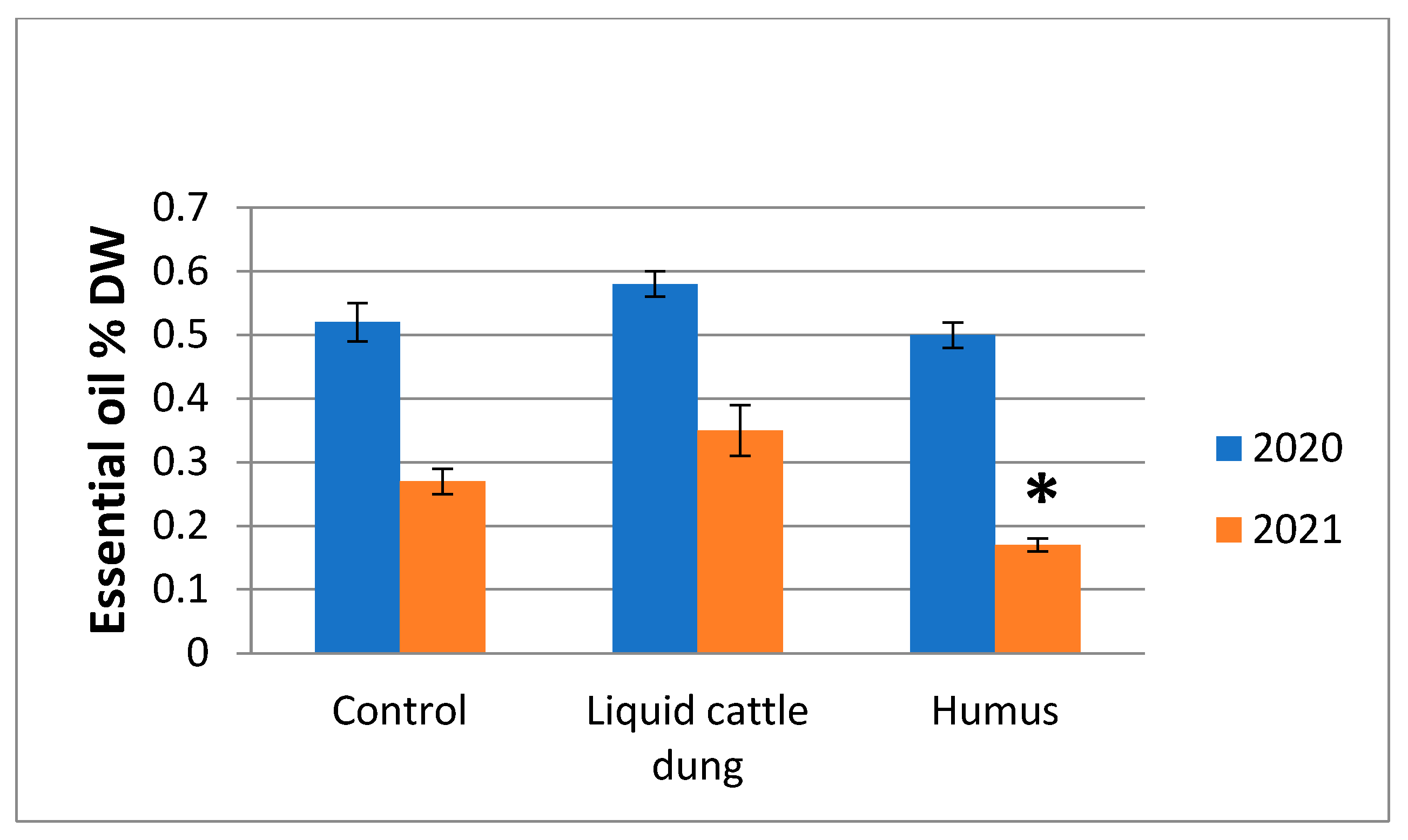
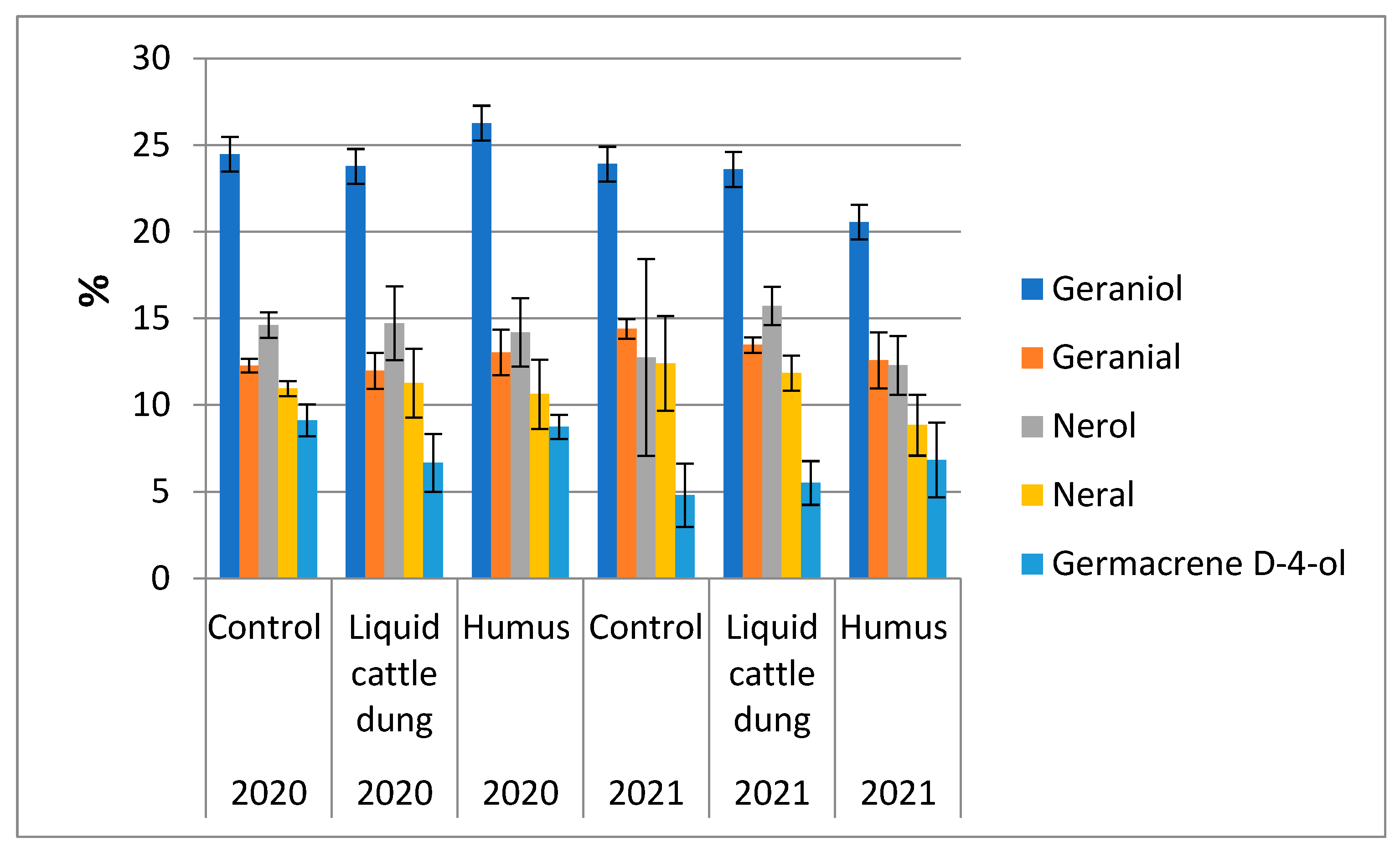
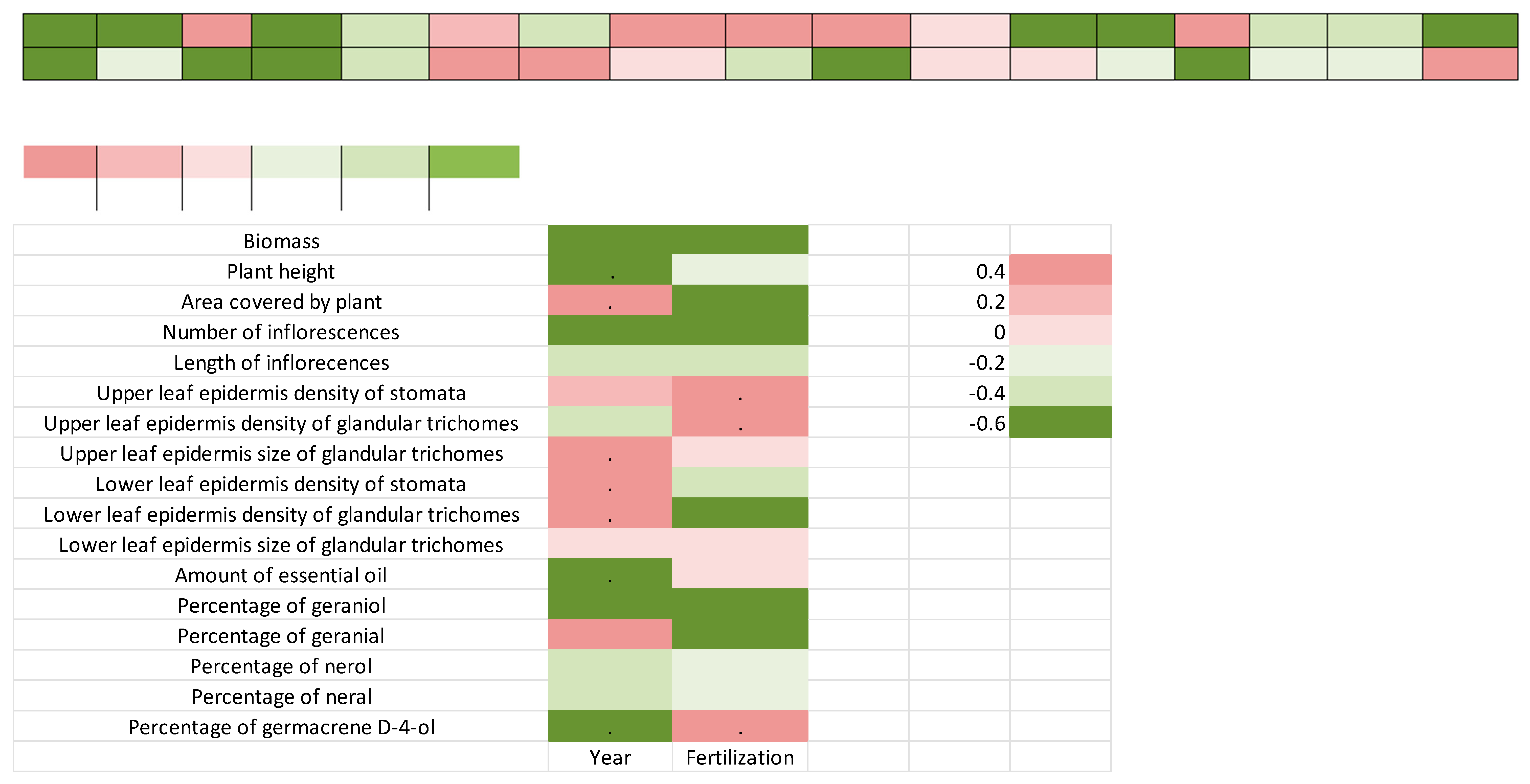
| Month | Temperature, °C | Rainfall, mm | Humidity, % | |||
|---|---|---|---|---|---|---|
| 2020 | 2021 | 2020 | 2021 | 2020 | 2021 | |
| April | 6.6 | 6.0 | 6.2 | 24.7 | 58.5 | 69.9 |
| May | 12.4 | 11.2 | 77.8 | 147 | 67.9 | 73.2 |
| June | 19.7 | 19.5 | 68.4 | 55 | 71.0 | 66.8 |
| July | 17.6 | – | 66.8 | – | 70.7 | – |
| August | 18.4 | – | 75.5 | – | 72.4 | – |
| Fertilization | Collection of Soil | pH | Organic Carbon, % | Sum Nitrogen, % | Soil Element, mg/kg | ||||||||
|---|---|---|---|---|---|---|---|---|---|---|---|---|---|
| K | P | Ca | Mg | S | Cu | B | Mn | Zn | |||||
| Control | 1 | 6.2 | 0.87 | 0.073 | 73 | 125 | 913 | 102 | 1.0 | 1.17 | 0.38 | 39.7 | 0.33 |
| 2 | 6.0 | 0.83 | 0.076 | 73 | 125 | 843 | 102 | 1.2 | 1.17 | 0.30 | 39.4 | 0.68 | |
| 3 | 6.0 | 0.83 | 0.077 | 69 | 120 | 800 | 90.8 | 1.4 | 1.35 | 0.45 | 38.7 | 0.47 | |
| 4 | 5.9 | 0.74 | 0.070 | 72 | 127 | 860 | 96.8 | 1.1 | 1.03 | 0.24 | 40.2 | 0.50 | |
| Mean ± SD | 6.02 ± 0.13 | 0.82 ± 0.05 | 0.074 ± 0.003 | 71.75 ± 1.89 | 124.25 ± 2.99 | 854.00 ± 46.74 | 97.90 ± 5.33 | 1.18 ± 0.17 | 1.18 ± 0.13 | 0.34 ± 0.09 | 39.50 ± 0.63 | 0.49 ± 0.14 | |
| Liquid cattle dung | 1 | 5.9 | 0.90 | 0.068 | 68 | 119 | 821 | 95.2 | 1.2 | 1.13 | 0.31 | 40.0 | 0.39 |
| 2 | 6.3 | 0.79 | 0.070 | 202 | 127 | 782 | 94.8 | 1.2 | 1.25 | 0.31 | 38.9 | 0.47 | |
| 3 | 6.1 | 0.89 | 0.086 | 180 | 131 | 850 | 108 | 1.2 | 1.11 | 0.42 | 38.5 | 0.51 | |
| 4 | 6.1 | 1.06 | 0.080 | 236 | 129 | 764 | 84 | 1.4 | 1.07 | 0.21 | 39.9 | 0.89 | |
| Mean ± SD | 6.1 ± 0.16 | 0.91 ± 0.11 | 0.076 ± 0.010 | 171.50 ± 72.74 | 126.50 ± 5.26 | 804.25 ± 38.68 | 95.50 ± 9.82 | 1.25 ± 0.10 | 1.14 ± 0.07 | 0.31 ± 0.09 | 39.33 ± 0.74 | 0.56 ± 0.22 | |
| Humus | 1 | 5.9 | 0.85 | 0.082 | 71 | 125 | 793 | 96.8 | 1.2 | 1.06 | — | — | — |
| 2 | 6.2 | 1.11 | 0.053 | 103 | 120 | 782 | 94.8 | 1.2 | 1.25 | — | — | — | |
| 3 | 5.9 | 1.0 | 0.080 | 85 | 123 | 825 | 96.2 | 1.3 | 1.19 | — | — | — | |
| 4 | 5.8 | 1.01 | 0.068 | 124 | 161 | 1068 | 104 | 1.7 | 1.04 | — | — | — | |
| Mean ± SD | 5.95 ± 0.17 | 0.99 ± 0.11 * | 0.070 ± 0.010 | 95.75 ± 22.94 | 132.25 ± 19.28 | 867.00 ± 135.24 | 97.95 ± 4.11 | 1.35 ± 0.24 | 1.14 ± 0.10 | — | — | — | |
| Fertilization | Collection of Soil | pH | Organic Carbon, % | Sum Nitrogen, % | Soil Element, mg/kg | ||||||||
|---|---|---|---|---|---|---|---|---|---|---|---|---|---|
| K | P | Ca | Mg | S | Cu | B | Mn | Zn | |||||
| Control | 1 | 6.2 | 0.85 | 0.068 | 63 | 125 | 809 | 94.4 | 1.2 | 0.99 | 0.20 | 40.4 | 0.94 |
| 2 | 6.1 | 0.77 | 0.072 | 71 | 113 | 840 | 98.4 | 1.3 | 1.09 | 0.20 | 40.0 | 0.30 | |
| 3 | 6.2 | 0.88 | 0.074 | 76 | 131 | 858 | 102 | 1.3 | 1.07 | 0.23 | 38.2 | 0.33 | |
| 4 | 5.9 | 1.04 | 0.082 | 64 | 120 | 753 | 80.0 | 1.2 | 1.11 | 0.26 | 36.0 | 0.40 | |
| Mean ± SD | 6.1 ± 0.14 | 0.89 ± 0.11 | 0.074 ± 0.010 | 68.50 ± 6.13 | 122.25 ± 7.63 | 812.50 ± 50.56 | 93.70 ± 9.64 | 1.25 ± 0.06 | 1.07 ± 0.05 | 0.22 ± 0.03 | 38.65 ± 2.01 | 0.49 ± 0.30 | |
| Liquid cattle dung | 1 | 6.1 | 0.86 | 0.076 | 176 | 121 | 793 | 96.8 | 1.1 | 1.06 | 0.16 | 38.0 | 0.81 |
| 2 | 6.4 | 0.82 | 0.082 | 256 | 118 | 750 | 93.6 | 1.6 | 1.15 | 0.23 | 39.3 | 0.37 | |
| 3 | 6.3 | 0.96 | 0.065 | 222 | 121 | 808 | 88.8 | 1.4 | 1.03 | 0.25 | 34.4 | 0.22 | |
| 4 | 6.0 | 0.91 | 0.083 | 206 | 124 | 756 | 83.2 | 1.3 | 1.21 | 0.37 | 37.5 | 0.53 | |
| Mean ± SD | 6.2 ± 0.18 | 0.89 ± 0.06 | 0.077 ± 0.008 | 215.00 ± 33.32 * | 121.00 ± 2.45 | 776.75 ± 28.21 | 90.65 ± 5.96 | 1.35 ± 0.21 | 1.11 ± 0.08 | 0.25 ± 0.09 | 37.30 ± 2.08 | 0.48 ± 0.25 | |
| Humus | 1 | 5.9 | 0.89 | 0.075 | 70 | 112 | 851 | 96.0 | 1.1 | 1.12 | — | — | — |
| 2 | 5.9 | 0.84 | 0.070 | 103 | 116 | 818 | 92.8 | 1.5 | 1.11 | — | — | — | |
| 3 | 6.1 | 0.88 | 0.071 | 78 | 113 | 779 | 84.8 | 1.8 | 1.06 | — | — | — | |
| 4 | 5.8 | 0.92 | 0.073 | 88 | 120 | 771 | 85.6 | 1.7 | 1.13 | — | — | — | |
| Mean ± SD | 5.92 ± 0.13 | 0.88 ± 0.03 | 0.072 ± 0.002 | 84.75 ± 4.22 | 115.25 ± 3.59 | 804.75 ± 37.04 | 89.80 ± 5.48 | 1.53 ± 0.31 | 1.11 ± 0.03 | — | — | — | |
| Leaf Epidermis | Anatomical Parameter of Leaves | Fertilization Treatment | |||
|---|---|---|---|---|---|
| Control | Liquid Cattle Dung | Humus | |||
| First experimental year | |||||
| Upper | Density of stomata | Mean ± SD | 69.0 ± 30.6 | 57.1 ± 18.2 | 71.0 ± 19.4 |
| in mm2 | Min | 5 | 20 | 41 | |
| Max | 117 | 97 | 133 | ||
| CV, % | 44 | 32 | 27 | ||
| Density of glandular | Mean ± SD | 10.0 ± 5.4 | 7.1 ± 4.5 | 16.3 ± 8.3 * | |
| trichomes in mm2 | Min | 0 | 0 | 5 | |
| Max | 20 | 15 | 36 | ||
| CV, % | 54 | 63 | 51 | ||
| Size of glandular | Mean ± SD | 54.6 ± 32.9 | 53.7 ± 35.1 | 59.4 ± 36.6 | |
| trichomes, μm | Min | 21 | 21 | 16 | |
| Max | 138 | 138 | 147 | ||
| CV, % | 60 | 65 | 61 | ||
| Lower | Density of stomata | Mean ± SD | 106.2 ± 68.1 | 174.6 ± 52.8 * | 135.3 ± 49.6 |
| in mm2 | Min | 15 | 82 | 56 | |
| Max | 265 | 286 | 230 | ||
| CV, % | 64 | 30 | 37 | ||
| Density of glandular | Mean ± SD | 9.0 ± 5.8 | 11.4 ± 5.8 | 8.0 ± 5.2 | |
| trichomes in mm2 | Min | 0 | 0 | 0 | |
| Max | 25 | 26 | 20 | ||
| CV, % | 64 | 51 | 65 | ||
| Size of glandular trichomes, μm | Mean ± SD | 62.6 ± 25.7 | 52.4 ± 33.7 | 71.8 ± 27.4 | |
| Min | 16 | 21 | 23 | ||
| Max | 106 | 138 | 115 | ||
| CV, % | 41 | 64 | 38 | ||
| Second experimental year | |||||
| Upper | Density of stomata | Mean ± SD | 61.8 ± 18.6 | 70.6 ± 18.4 | 54.8 ± 16.6 |
| in mm2 | Min | 26 | 36 | 20 | |
| Max | 97 | 102 | 87 | ||
| CV, % | 30 | 26 | 30 | ||
| Density of glandular | Mean ± SD | 10.2 ± 4.5 | 10.2 ± 6.4 | 6.2 ± 4.1 * | |
| trichomes in mm2 | Min | 5 | 0 | 0 | |
| Max | 20 | 26 | 15 | ||
| CV, % | 44 | 63 | 66 | ||
| Size of glandular trichomes, μm | Mean ± SD | 64.5 ± 35.6 | 72.5 ± 30.4 | 76.2 ± 28.2 | |
| Min | 14 | 23 | 24 | ||
| Max | 219 | 127 | 127 | ||
| CV, % | 55 | 42 | 37 | ||
| Lower | Density of stomata | Mean ± SD | 200.5 ± 55.4 | 174.3 ± 50.8 | 207.6 ± 66.5 |
| in mm2 | Min | 87 | 97 | 97 | |
| Max | 291 | 265 | 337 | ||
| CV, % | 28 | 29 | 32 | ||
| Density of glandular | Mean ± SD | 11.9 ± 7.1 | 9.3 ± 5.1 | 9.6 ± 4.7 | |
| trichomes in mm2 | Min | 0 | 5 | 5 | |
| Max | 31 | 20 | 20 | ||
| CV, % | 60 | 55 | 49 | ||
| Size of glandular trichomes, μm | Mean ± SD | 67.1 ± 23.9 | 61.8 ± 32.1 | 63.5 ± 22.9 | |
| Min | 16 | 21 | 21 | ||
| Max | 115 | 161 | 117 | ||
| CV, % | 36 | 52 | 36 | ||
Publisher’s Note: MDPI stays neutral with regard to jurisdictional claims in published maps and institutional affiliations. |
© 2022 by the authors. Licensee MDPI, Basel, Switzerland. This article is an open access article distributed under the terms and conditions of the Creative Commons Attribution (CC BY) license (https://creativecommons.org/licenses/by/4.0/).
Share and Cite
Vaičiulytė, V.; Ložienė, K.; Sivicka, I. Effect of Organic Matter Fertilizers on the Composition of Volatiles, Morphometrical and Anatomical Parameters of Essential Oil-Bearing Thymus × citriodorus Cultivated in an Open Field Conditions. Horticulturae 2022, 8, 917. https://doi.org/10.3390/horticulturae8100917
Vaičiulytė V, Ložienė K, Sivicka I. Effect of Organic Matter Fertilizers on the Composition of Volatiles, Morphometrical and Anatomical Parameters of Essential Oil-Bearing Thymus × citriodorus Cultivated in an Open Field Conditions. Horticulturae. 2022; 8(10):917. https://doi.org/10.3390/horticulturae8100917
Chicago/Turabian StyleVaičiulytė, Vaida, Kristina Ložienė, and Irina Sivicka. 2022. "Effect of Organic Matter Fertilizers on the Composition of Volatiles, Morphometrical and Anatomical Parameters of Essential Oil-Bearing Thymus × citriodorus Cultivated in an Open Field Conditions" Horticulturae 8, no. 10: 917. https://doi.org/10.3390/horticulturae8100917





